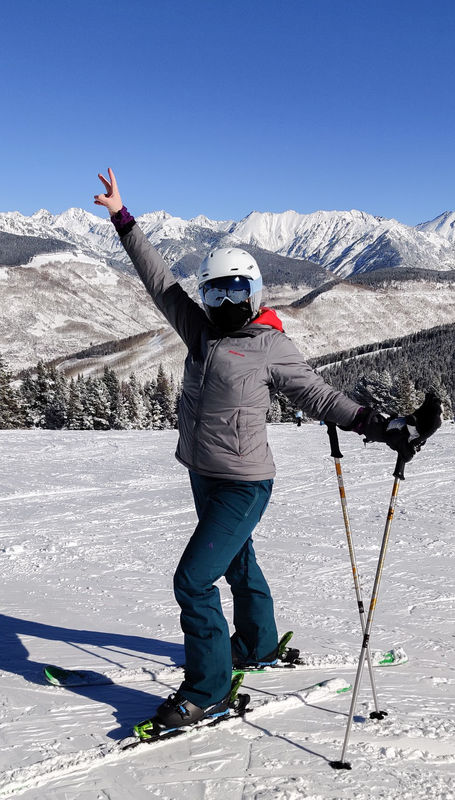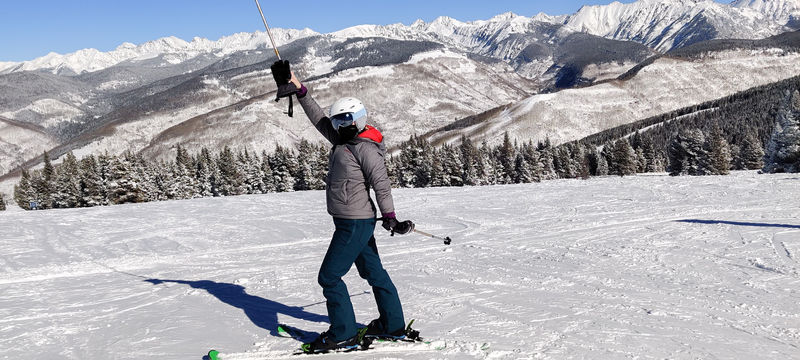 When you buy something using links in our stories, we may earn a small commission. Read more about our policy.
When you buy something using links in our stories, we may earn a small commission. Read more about our policy.
Just because you didn’t grow up in a ski family or near a mountain, doesn’t mean you can’t become an excellent skier later in life (says the girl from Florida). Sure, seeing all the kids blowing past you, ducking into the trees and getting airborne may feel a bit unfair, but with practice, you can get there, too.
It took exactly one day of skiing—my very first day on the slopes in my early 30s—and I was hooked. Stuffing away the fear that I was too old to learn a challenging, new sport, I dove in headfirst—sometimes quite literally.
I learned a lot on my first couple ski trips, and even more since moving to Colorado and committing most winter weekends to the slopes. Even if you only do a few of these things, you’ll be on your way to the X Games in no time.
Get a ski pass
It ain’t cheap, but skiing as often as you can will improve your skills greatly, and that much more quickly. If you use a ski pass 5-6 times in a season, it pays for itself. Having the option to hit the slopes on any given weekend (or weekday—if you’re lucky—to avoid crowds) is a beautiful thing because, let’s face it, you can’t master anything in a day or two. Give yourself some time to learn and commit to a month or full season of skiing to truly see progress and get comfortable on the mountain.
The conditions won’t always be great, and sometimes you might do a few runs and just not be feeling it so you pack it in and head home. That’s okay because those days are balanced out by the truly fantastic days when everything just clicks and you get in miles and miles of skiing, getting that much closer to your goals. Having a pass gives you unlimited opportunities to practice.
Pick a mountain that’s good for beginners
Some resorts are known to be more advanced than others, and some have more options for easy terrain to practice on (green for beginners and blue for a bit more advanced). Once you graduate from the bunny slopes (probably within a day or two), green runs are your best friend, and you’ll start to feel like a real skier! Make sure the mountain has plenty of greens, ideally long and wide terrain so you can easily make your way down and get comfortable gaining speed (and slowing down).
Typically, ski resorts in the western US have more fluffy, beginner-friendly slow, whereas east coast skiing can be icy, hard, and unforgiving. If at all possible, try to learn in the west (Colorado, Utah, and California are incredible). Soft, fresh powder presents its own challenges (refer to the below tip on sticking to groomed runs), but it’s much nicer falling on fluff than ice. You definitely want to avoid the hard, icy terrain as a beginner if you can.
It’s also best to avoid crowded places. Other people (especially other beginners) can be stressful to ski near as you’re learning. Rather than focusing on what you’re doing, you’re worried about hitting someone else—or vice versa.
Invest in ski boots and get them fitted
Yes, you can rent skis, poles, and boots, but boots are by and large the most important piece of ski equipment you can invest in. If you’re serious about learning to ski, buy your own boots and get them fit by a professional. Ill-fitting boots can easily ruin a day on the slopes, causing cramps, aches, pinches, and other pains that’ll get in the way of mastering your ski skills before you ever get a chance to try.
Head to a local ski shop and let the pros help guide you. Try on different brands to see how they fit. You want a boot that is snug (i.e. tight). It might not be the most comfortable while walking around the shop, but when you’re out on the mountain, it’s important your foot is nice and cozy inside the boot, giving you total control over the skis with each movement. A proper fitting can also shape the boot to your foot and help avoid any areas that might rub.
Pro tip: Renting ski gear can be expensive. Some ski shops offer season-long rental packages, which is a great way to cut down the costs if you aren’t ready to fully invest but also don’t want to stop by the shop every time you head to the mountain. For reference, when I looked into it in late 2020, ski rentals were $50/day and season-long rentals were $220. It easily pays for itself after a few days, and you save so much time on each trip.
Pro tip: Buy gear at the end of ski season to save tons of money. Whether you’re getting new or used gear, there are huge end-of-winter and off-season sales you can take advantage of.
Take a lesson
Private lessons are the quickest way to learn to ski. You wouldn’t think twice about putting a kid in ski lessons, so it shouldn’t be any different for adults when they’re learning. With individual attention, the instructor can work with you on your specific needs. It’s more expensive than a group lesson, but the results will be that much faster. If you’re shy or nervous, you’ll probably be more comfortable with one-on-one coaching over a group setting, too.
A lot of learning to ski is conquering fears (of speed and obstacles). Ski instructors help with not only the technical side of skiing but the emotional aspect, as well. They are patient and supportive (they should be, anyway) and will help you overcome your fears while learning proper form and technique.
I have a lot of friends who are better skiers than I am, but they aren’t really able to teach me how to ski. They took lessons years ago and it’s all intuitive to them now. Being able to do something well and be able to teach someone else how to do it are two completely different skill sets. Let a professional show you the way.
Take breaks
Skiing engages muscles you might not use that often. It’s easy to get tired, especially as you’re learning. Pace yourself throughout the day with a break every two hours or so. Resting and hydrating is so important to rejuvenate the body and get the most out of your day. It’s also a great chance to loosen your boots for a bit and watch other skiers.
Most falls and accidents happen in the afternoon when you’re fatigued. Know when to call it a day.
Ski with people who are better than you
Skiing with friends you trust and who are patient and supportive can help boost your confidence and challenge you in new ways. It’s easy to stick to the runs you know and love, but friends might encourage you to try new runs, and with a little practice, you’ll conquer new heights and speeds.
This doesn’t mean you have to keep up with your friends on each run, but it’s a fun way to push yourself and test your limits. You can always meet them at the bottom of the run and take the lift back up together. Or, they can take the run all the way to the bottom, while you catch the lift half-way down, meeting back up at the top. I don’t like the feeling of keeping my friends waiting, but usually they don’t mind, and when the time comes, we’re all happy to do our own thing at our own pace and meet back up after a couple runs.
Ski alone
When I committed to learning to become a better skier, I skied solo A LOT. It’s a great way to focus and practice at your own pace without feeling like anyone is waiting on you or you’re taking more breaks than you want because someone in your crew has to use the bathroom or wants to grab a beer. You can also meet new friends and learn about the mountain or other great nearby mountains. I love chatting up strangers on the lifts.
Get out of the backseat
This is the only technical tip included because it’s an important one. It’s a popular phrase to remind beginner skiers to lean forward in their boots, bending at the ankles and putting pressure toward the front of the skis. It might seem counter-intuitive at first as you’re focusing on controlling your speed down the mountain and may naturally tend to lean backward, but by learning forward (and staying out of the backseat), you have more control over your skis and therefore more control turning, slowing, and stopping.
Stick to groomed trails
Experienced skiers and snowboarders lives for powder days. As a beginner, fresh, deep snow presents whole new challenges. I recently went to Vail after a night of snowing that continued into the morning, and nothing was groomed. Everyone was stoked—except me. The runs were bumpy from being skied on and not-yet-groomed., and the snow was deeper and softer, which made staying upright difficult. I fell… a lot. The next day, most of the runs were groomed and it was glorious (for me anyway… the pros still preferred the bumpy/soft stuff).
As a beginner, stick to groomed trails. When you’re ready, you can venture off-trail for some of the fresh powder and see what it’s like. It’s a different skill set completely (and ideally you’re on skis that can handle soft powder).
Dress well and layer up
Dressing appropriately isn’t just for comfort, it’s for safety. The top of the mountain (and on the lifts) will be significantly colder and windier. Layer up so you can easily unzip your jacket as needed, and wear proper ski clothes with ventilation. As a beginner, you may feel like you’re working harder than others, and you will likely work up a sweat despite the outside temperature.
Also, for the love of all things holy, wear a helmet. When I first learned to ski, I didn’t have my own gear (and I was with friends who didn’t wear helmets), so I just wore a beanie. Granted it was Big Bear Mountain in Southern California and in the 40s so not that cold at all. But, as I got better and wanted to challenge myself on harder runs, a helmet gave me confidence knowing I was safe(r). It also helps keep your head much warmer.
Pro tip: Don’t forget the sunscreen. Sun reflects off snow, so even if you’re cold, you can get sunburnt. Lather up your face and don’t forget your lips.
MORE: What to Wear Skiing
Stay positive
Adults learning to ski will likely have higher expectations for themselves than a kid who’s out there just to have fun or because they’re being forced by their parent. You’re investing money and time into the learning the sport, and you’ll probably want to see results quickly. At least that’s how I was. It may (or may not) come as quickly as you’d like. Stay positive and be patient with yourself as you’re learning. Remember you’re out there to have a good time. It’s beautiful, and you’re breathing in fresh mountain air. At the very least, that’s a day well spent.
On that note, don’t compare yourself to others. As with all things in life, everyone is on their own journey. Take it easy on yourself as you’re learning. Keep your expectations low and set manageable goals. Falling and failing is part of learning. Go play, and have fun!


 When you buy something using links in our stories, we may earn a small commission.
When you buy something using links in our stories, we may earn a small commission.